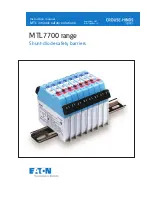
8
INM 7700 Rev 12
5 .3 .2
Earthing an installation
See figure 15. Connections from the DIN-rail to a suitable plant
earth are made from ETL7000 earth terminals. These clip onto
the DIN-rail as described in section 4.3.3 to make the vital earth
connection with the rail and the barriers. They are provided with
two screw-clamp terminals, to one of which a copper conductor to
plant earth should be connected. This should have a resistance no
greater than 1Ω though to increase safety and reduce interference,
a resistance as close to 0.1Ω as possible is preferable. The cross-
sectional area of the conductor should be as least 4mm
2
(12 AWG).
It is advisable to mount one ETL7000 earth terminal at each end
of a column of barriers to provide redundancy by connecting both
ETL7000 terminals to the plant earth. This makes it possible to
introduce a multimeter into one of the loops to measure loop
resistance without breaking the earth connection (figure 16) – a
test which should be done periodically. In these circumstances,
resistance for each cable loop should not exceed 2Ω.
The IS plant earth conductors should be clearly identified to warn
against unauthorised interference. Though not mandatory, it is
recommended that this should be done by winding blue insulating
tape round the conductors at intervals along their length.
WARNING
Do not use earth foot terminal as an IS earth termination.
Make IS earth connections using an ETL7000 earth terminal
as described in section 5.3.2.
5 .3 .3
Earthing an earth rail assembly
On installations which include earth rail assemblies (see section
4.3.4) an earth conductor, normally copper wire with a cross-
sectional area of at least 4mm
2
(12AWG) must be connected
between ETM7 earth terminals located at each end of the rail and
the ‘spare’ terminals on the ETL7000 terminals at each end of the
column of barriers. See figure 17.
5 .3 .4
Hazardous-area equipment isolation
Hazardous-area equipment and interconnections should be
isolated from earth sufficiently to be capable of withstanding a
500V isolation test. Such tests can, however, only be undertaken
when the area is gas free so it is fortunate that most circuits can be
tested at low voltages. To do this:
a) Disconnect from the barrier any cable connected directly to
earth or returned through a barrier with a nominal voltage of
less than 10V.
b) Check the resistance to earth of the safe-area terminals with a
multimeter; it should be greater than 100kΩ.
Note:
some hazardous-area equipment (eg, pH and conductivity
instrumentation) is unable to withstand this insulation test. As an
alternative, in these circumstances the system can comply with
the installation requirements described in IS sketch 121. See also
12.2.4.in BS EN 60079-14.
3
4
1
2
M
Logic signal
1
5
MTL7798
(MTL7799)
3
4
1
2
M
250
Ω
3
4
1
2
MTL7741
5
6
7
8
6
0V
0V
1-5V
Contact
signals
Power Bus
PB7700
Loop power to
opposite ends to
allow module
removal
Power
Connections
Hazardous
Area
Safe
Area
Figure 14:
Typical application of the Power Bus
ETL7000 earth
terminal
To IS earth
Figure 15:
Plant earth connection to ETL7000 earth terminal
ETL7000 earth
terminal
Loop
resistance
<2
Ω
Local distribution transformer
Resistance meter or
bond integrity monitor
Figure 16:
Earthing an installation with two conductors and
providing resistance test facilities
























